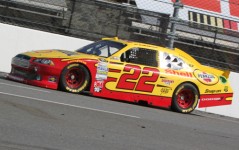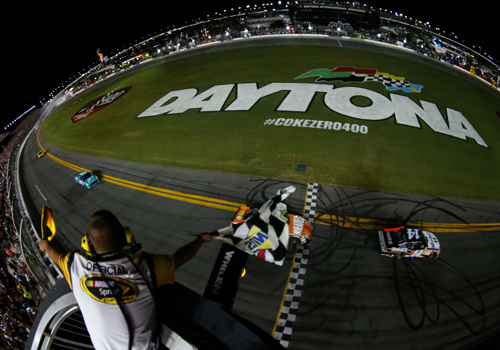 Last Saturday’s announcement that said NASCAR Sprint Cup Series driver A J Allmendinger has been “temporarily suspended” by officials for a violation of their substance abuse policy was, in a word, stunning. This announcement was one of those rare times when NASCAR officials, competitors, the media and the fans were all rendered speechless at the same time.
Last Saturday’s announcement that said NASCAR Sprint Cup Series driver A J Allmendinger has been “temporarily suspended” by officials for a violation of their substance abuse policy was, in a word, stunning. This announcement was one of those rare times when NASCAR officials, competitors, the media and the fans were all rendered speechless at the same time.
Allmendinger began this racing season by landing one of the most prestigious rides in Sprint Cup Racing: the #22 Roger Penske Racing Shell Penzoil Dodge. The arrangement was on a one year, let’s wait and see what happens, basis. Allmendinger openly referred to the ride as the opportunity of a life time and even said it was his “best last chance to make it in NASCAR racing.” It just didn’t seem possible that this opportunity would be upset by the element of substance abuse. It’s still hard to imagine that this happened.
However, despite the sad circumstances, it’s still prudent to once again praise NASCAR officials for creating and enforcing one of the most strict substance policies in organized professional sports. The potential for collateral damage, that comes with an impaired driver behind the wheel of a high performance race car, is simply too great.
During the 2007 racing season it became apparent that the element of substance abuse had made its way to NASCAR racing. That was the year when a young driver’s heroin use created a downward spiral in his quality of life. The driver eventually admitted that he was using the drug prior to the start of races. That’s when NASCAR decided it was time to spring into action and take this situation to task before it spread any further. They had the full endorsement of the drivers, from all three of NASCAR’s touring series, who made it clear they absolutely didn’t want to share the race track with an impaired colleague.
By the beginning of the 2008 season, the toughest substance abuse policy in professional sports was now in place. During each NASCAR racing weekend officials makes a random selection of 15 team members and orders them to submit a urine sample to its Medical Review Officer. These samples are equally divided into two containers and labeled “sample A” and “sample B.” Sample A is immediately tested first. It generally takes three to five days before the final test results are in. If sample A results indicates a violation of the substance abuse policy, the team member is automatically placed on temporary suspension.
Sample B is part of NASCAR’s check and balance system for their substance abuse policy. It’s a second test that could either confirm or possibly even refute the results of the first test. During the next phase of the policy, the NASCAR team member has a period of 72 hours to officially request the testing of sample B. If NASCAR does not receive a request for a sample B test within the time allotment, or if the test is conducted and also produces a positive result, then the team member is automatically place on indefinite suspension.
Once the suspension become indefinite, then it’s a long and arduous road the team member has to travel before a return to NASCAR will be granted. However, the substance abuse policy does have a benevolent clause that is often referred to as “the road to recovery.” If the team member is willing to successfully complete an approved rehabilitation program then his reinstatement to NASCAR racing is possible.
According to reports, A J Allmendinger was randomly selected for drug testing during the NASCAR weekend at the Kentucky Speedway held June 28th through the 30th. Other reports state that NASCAR was informed that Allmendinger’s sample A test was positive on Saturday approximately four hours prior to the start of the Daytona race. It’s presumed that a meeting was called followed by the preparation of an official statement and then Penske Racing was informed their driver was now on temporary suspension.
That official statement was read to the media by Steve O’Donnell, NASCAR Senior Vice President of Racing Operations, who said: “driver A J Allmendinger has been temporarily suspended from NASCAR competition based upon notification of a positive “A” test NASCAR received from the Medical Review Officer as stated in section 19-11B (6,7) of the NASCAR Substance Abuse Policy. Pursuant to the rule book, Allmendinger has the opportunity to request within the next 72 hours that his “B” sample be tested. NASCAR will follow its policies and procedures set forth in the rule book in dealing with this matter.”
In a very appropriate gesture, O’Donnell made it very clear that NASCAR would not be making any further public statements at this time and would not be taking any questions from the media regarding this matter.
Not long after NASCAR’s stunning announcement, a prepared statement from Penske Racing was issued that said: “NASCAR notified Penske Racing this afternoon that A J Allmendinger was administered a drug test earlier this week, and those results tested positive. NASCAR has a strict drug testing program that Penske Racing fully supports. Penske Racing will work with NASCAR through this process and its next steps. Sam Hornish Jr will drive the #22 car in Saturday’s Coke Zero 400.”
Placing Sam Hornish Jr in the Penske #22 Dodge for the Daytona race was a logical choice. He has been driving for Roger Penske for many years now both in the Indy Racing League and NASCAR. He has multiple Sprint Cup starts for the team at Daytona and this year has been driving the Penske Dodge in the NASCAR Nationwide Series. However, there was one little problem regarding Hornish driving in this Sprint Cup race: he wasn’t exactly at Daytona when all of these developments occurred.
After driving his Penske Dodge to a very respectable tenth place finish in Friday night’s Daytona Nationwide Series race, Hornish flew home to North Carolina. He later said he spent some quality time at a lake with his family on Saturday morning and then reported for duty at his second job Saturday afternoon. That would be his co hosting job on “The Speed Report”, the very popular live racing program aired each weekend on the SPEED Channel. It was later reported that Hornish was actually on the set, during a live segment, when the frantic call from Penske Racing arrived.
Roger Penske wasn’t exactly in Daytona when all of this happened either. He had elected to spend the weekend with his Indy Racing League teams in Toronto-Canada. He very calmly began handling any and all details of a tough situation over his cell phone. There’s a reason why they call him “The Captain.”
It was reported that when Penske Racing received the news regarding Allmendinger’s suspension, they had a limited amount of time to handle the replacement driver situation before the race started. The Penske Racing organization deserves a standing ovation for handling the sequence of events that soon followed. First, Hornish was told to run home, pack his racing uniform and shoes and proceed to the Concord-North Carolina airport. A private jet, owned by Penske that was used to fly the race teams to Daytona, was immediately dispatched to North Carolina to pick up Hornish.
Next the team was given orders to start prepping the car for Hornish. That process included switching the driver’s seat to one more suitable for Hornish’s height and frame. The process also included adjusting the height of the transmission shifter, steering column, the seat belts and even the height of the pedals on the floorboard.
With a genuine concern that Hornish might not make it to Daytona in time, Penske arranged for Nationwide Series driver, and ironically also a SPEED Channel television personality, to be their back up driver for the back up driver. This was ironic because Wallace had already been named as the back up driver for Kevin Harvick in case he had to fly home to North Carolina to witness the birth of his first child. It turned out that his wife delivered a very healthy baby son the following day. Wallace was observed standing in front of the Penske Racing garage stall wearing Kevin Havick’s fire suit while holding A J Allmendinger’s helmet. He was also overheard to say “all this is uncomfortable for everybody.”
Meanwhile Hornish, dressed for racing, arrived at Daytona and, with the help of a pre arranged police escort, made a high speed run to the race track. He got there just in time to climb inside of the Penske Dodge and receive the command to start his engine. Due to the driver change Hornish had to start at the rear of the field but made quick work of developing race rhythm and advancing his position. Unfortunately a blown tire, on lap 82, found him spinning onto the backstretch which led to a 33d place finish.
To no real surprise, the media covering the Indy Racing League event in Toronto was more than interested in the Allmendinger story and went looking for Roger Penske. In a comment made to “USA Today”, he said: “you know it’s a disappointment at this particular time, but we’re going to wait and see what the second test results are before we make any comments or decisions. I don’t it’s fair to him. I think as you look at sports, things happen like this. It’s unfortunate, but I really don’t want to make a statement pro or con right now. I’m counting on another test, (the “B” sample test), being proper for him within 72 hours, and at that point we’ll make a decision.”
Needless to say, at this point there are more questions than answers to this sad story and it’s virtually guaranteed this will be the top racing story in the days ahead while we all wait for the results of the second test.
Still, it’s important that we continue to praise NASCAR for recognizing this problem area over five years ago and creating a substance abuse policy and procedure that should be emulated by other professional sports all over the world.








oh sure. NA$CAR hasn’t had a good witch-hunt for a long time.